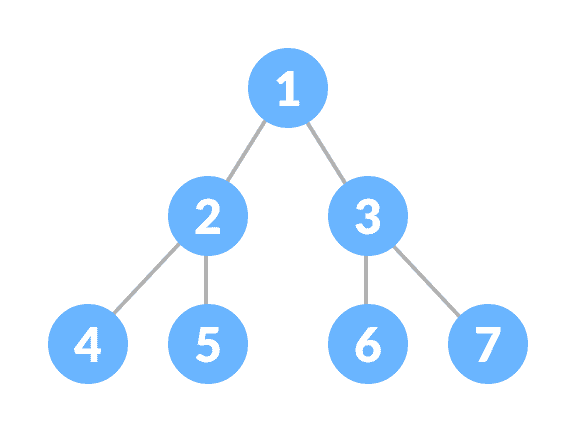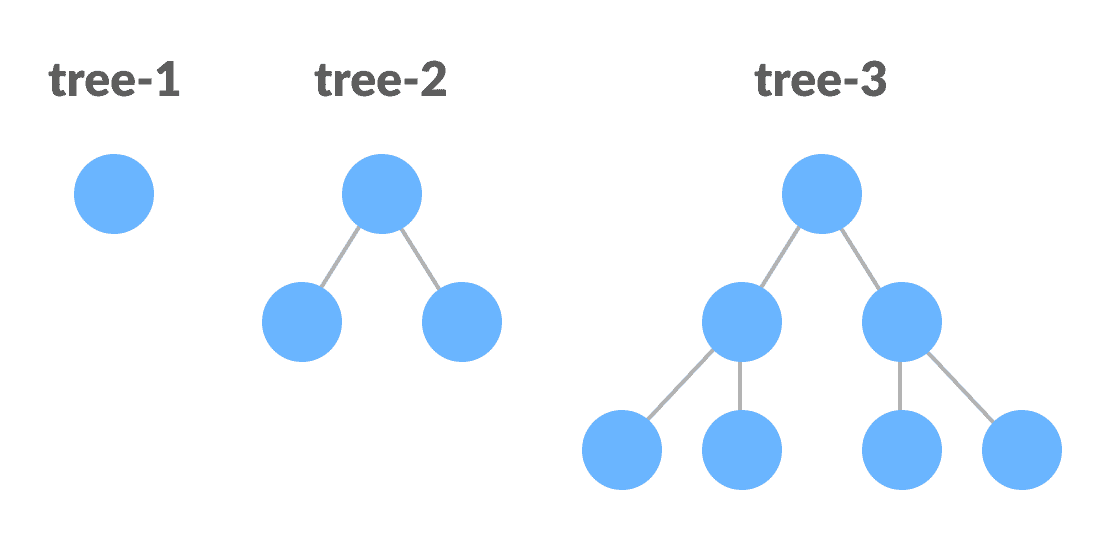在本教程中,您将学习完美二叉树。 此外,您还将找到一些用于检查 C,C++ ,Java 和 Python 中完美二叉树的示例。
完美二叉树是一种二叉树,其中每个内部节点恰好有两个子节点,而所有叶节点都处于同一级别。

完美二叉树
所有内部节点的度数均为 2。
递归地,可以将完美二叉树定义为:
- 如果单个节点没有子节点,则它是高度为
h = 0的完美二叉树, - 如果节点具有
h > 0,则如果其两个子树的高度均为h - 1并且不重叠,则它是理想的二叉树。

完美二叉树(递归表示)
Python,Java 和 C/C++ 示例
以下代码用于检查树是否是完美二叉树。
# Checking if a binary tree is a perfect binary tree in Pythonclass newNode:def __init__(self, k):self.key = kself.right = self.left = None# Calculate the depthdef calculateDepth(node):d = 0while (node is not None):d += 1node = node.leftreturn d# Check if the tree is perfect binary treedef is_perfect(root, d, level=0):# Check if the tree is emptyif (root is None):return True# Check the presence of treesif (root.left is None and root.right is None):return (d == level + 1)if (root.left is None or root.right is None):return Falsereturn (is_perfect(root.left, d, level + 1) andis_perfect(root.right, d, level + 1))root = Noneroot = newNode(1)root.left = newNode(2)root.right = newNode(3)root.left.left = newNode(4)root.left.right = newNode(5)if (is_perfect(root, calculateDepth(root))):print("The tree is a perfect binary tree")else:print("The tree is not a perfect binary tree")
// Checking if a binary tree is a perfect binary tree in Javaclass PerfectBinaryTree {static class Node {int key;Node left, right;}// Calculate the depthstatic int depth(Node node) {int d = 0;while (node != null) {d++;node = node.left;}return d;}// Check if the tree is perfect binary treestatic boolean is_perfect(Node root, int d, int level) {// Check if the tree is emptyif (root == null)return true;// If for childrenif (root.left == null && root.right == null)return (d == level + 1);if (root.left == null || root.right == null)return false;return is_perfect(root.left, d, level + 1) && is_perfect(root.right, d, level + 1);}// Wrapper functionstatic boolean is_Perfect(Node root) {int d = depth(root);return is_perfect(root, d, 0);}// Create a new nodestatic Node newNode(int k) {Node node = new Node();node.key = k;node.right = null;node.left = null;return node;}public static void main(String args[]) {Node root = null;root = newNode(1);root.left = newNode(2);root.right = newNode(3);root.left.left = newNode(4);root.left.right = newNode(5);if (is_Perfect(root) == true)System.out.println("The tree is a perfect binary tree");elseSystem.out.println("The tree is not a perfect binary tree");}}
// Checking if a binary tree is a perfect binary tree in C#include <stdbool.h>#include <stdio.h>#include <stdlib.h>struct node {int data;struct node *left;struct node *right;};// Creating a new nodestruct node *newnode(int data) {struct node *node = (struct node *)malloc(sizeof(struct node));node->data = data;node->left = NULL;node->right = NULL;return (node);}// Calculate the depthint depth(struct node *node) {int d = 0;while (node != NULL) {d++;node = node->left;}return d;}// Check if the tree is perfectbool is_perfect(struct node *root, int d, int level) {// Check if the tree is emptyif (root == NULL)return true;// Check the presence of childrenif (root->left == NULL && root->right == NULL)return (d == level + 1);if (root->left == NULL || root->right == NULL)return false;return is_perfect(root->left, d, level + 1) &&is_perfect(root->right, d, level + 1);}// Wrapper functionbool is_Perfect(struct node *root) {int d = depth(root);return is_perfect(root, d, 0);}int main() {struct node *root = NULL;root = newnode(1);root->left = newnode(2);root->right = newnode(3);root->left->left = newnode(4);root->left->right = newnode(5);root->right->left = newnode(6);if (is_Perfect(root))printf("The tree is a perfect binary tree\n");elseprintf("The tree is not a perfect binary tree\n");}
// Checking if a binary tree is a full binary tree in C++#include <iostream>using namespace std;struct Node {int key;struct Node *left, *right;};// New node creationstruct Node *newNode(char k) {struct Node *node = (struct Node *)malloc(sizeof(struct Node));node->key = k;node->right = node->left = NULL;return node;}bool isFullBinaryTree(struct Node *root) {// Checking for emptinessif (root == NULL)return true;// Checking for the presence of childrenif (root->left == NULL && root->right == NULL)return true;if ((root->left) && (root->right))return (isFullBinaryTree(root->left) && isFullBinaryTree(root->right));return false;}int main() {struct Node *root = NULL;root = newNode(1);root->left = newNode(2);root->right = newNode(3);root->left->left = newNode(4);root->left->right = newNode(5);root->left->left->left = newNode(6);root->left->left->right = newNode(7);if (isFullBinaryTree(root))cout << "The tree is a full binary tree\n";elsecout << "The tree is not a full binary full\n";}
完美二叉树定理
- 高度为
h的完美二叉树具有2^(h+1) – 1节点。 - 具有
n个节点的理想二叉树的高度为log(n + 1) – 1 = Θ(ln(n))。 - 高度为
h的理想二叉树具有2^h叶节点。 - 完美二叉树中节点的平均深度为
Θ(ln(n))。

